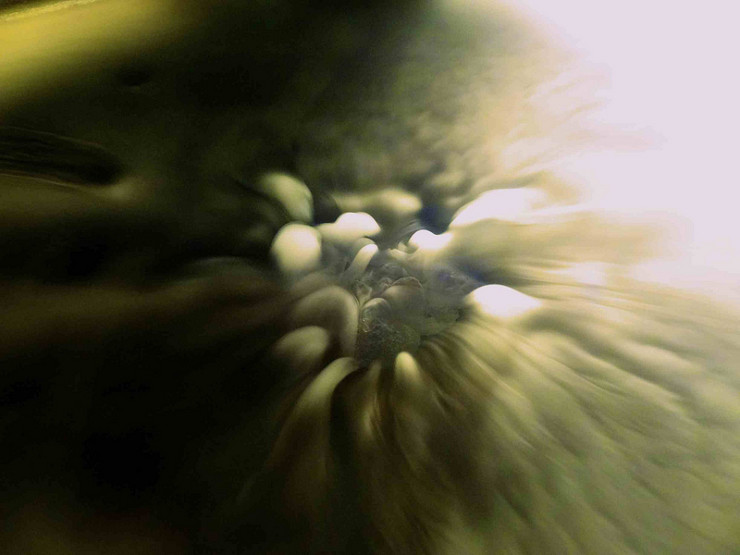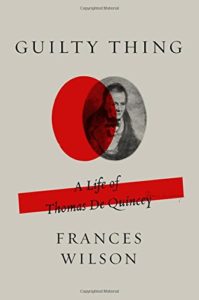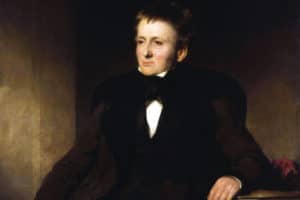
He was physically small, just under five feet tall. He was constantly in debt, hounded by his creditors, often shuttling between his family and an official sanctuary at Holyrood Abbey in Edinburgh. As a young man, he stalked William Wordsworth and Samuel Taylor Coleridge. He married well below his station, and while fathering nine children he would abandon his family for months at a time.
He was also one of the most brilliant men of his age – an age that specialized in producing brilliant men (and women). His essays are still considered among the best ever written. He created a literary sub-genre – the memoir of addiction. He invented a new kind of professional critic, creating the review-like essay (still a trademark of The New York Times Book Review, The London Review of Books, and numerous other publications).

Thomas De Quincey (1785-1859) came of age in the Romantic era, was friends with Wordsworth and Coleridge and their families, and likely did more to shape the literary canon of the 19th and 20th centuries than any other writer. And he is the subject of a new biography, Guilty Thing: A Life of Thomas De Quincey, by Frances Wilson.
Wilson notes (and admires) previous biographies of De Quincey (the “De” in his name was an affectation of his mother’s), but says she’s written a “De Quinceyean” biography. And it is one that certainly gets inside its subject’s mind (no small achievement, that), follows his movements around Britain, and places him and his work within his context. She highlights his personal failures as much as his literary successes, and points out that he was never financially successful in his lifetime.
“At the core of De Quincey’s personality,” Wilson says, “were his addictions. Opium was one and debt was another; his relationship with both was a manifestation of the same fear.” De Quincey lived in a time when opium, often prescribed in the form of drops of laudanum, was widely and commonly used for a host of ailments. Opium’s addictive properties weren’t recognized until it was in widespread use. Coleridge was, perhaps, a more famous opium addict, but De Quincey put it on the map with Confessions of an English Opium Eater, which would eventually give birth to a literary sub-genre. (His mother, Wilson says, became known as “the Opium-Eater’s mother”).

Thomas De Quincey by Sir John Watson-Fordon (1846)
He was also fascinated with violent crime, and especially murder. He avidly followed accounts of notorious murders, and eventually wrote an essay, On Murder, that became almost as famous as his account of opium addiction.
Wilson goes into extensive detail about two of De Quincey’s most important relationships – Wordsworth and Coleridge. He was almost mesmerized with their poetry, and finally worked up enough courage (it took years) to introduce himself to Wordsworth at Dove Cottage in the Lake District. De Quincey would even become the tenant of Dove Cottage after Wordsworth and his family moved to larger quarters, and, according to Wilson, turned it into something akin to a rural opium den. His relationships with the two poets moved between extremes, and he would eventually write rather critical, almost waspish, biographies of both. Wilson points out, however, that De Quincey had one of the deepest insights of anyone about Wordsworth – that the reach of his poetry exceeded the personality of the man.
Americans, the biographer writes, seemed to have understood and appreciated De Quincey better than his own British contemporaries. Hawthorne loved his work; Poe “borrowed” from it (and De Quincey never acknowledged Poe’s existence). And it was an American publisher, Ticknor and Fields, who first brought out a collection of De Quincey’s essays – in 22 volumes.

Frances Wilson
Besides her current work on De Quincey, Wilson is a critic and journalist, and the author of four previously published books: The Courtesan’s Revenge: The Life of Harriette Wilson, the Woman Who Blackmailed the King (2003); The Ballad of Dorothy Wordsworth: A Life (2009); How to Survive the Titanic: The Sinking of J. Bruce Ismay(2011); and Literary Seductions: Compulsive Writers and Diverted Readers(2014). She lives in London.
Guilty Thing is a fine biography, a fine read, a captivating portrait of a man whose literary influence is still felt today, more than 150 years after his death. He changed the shape and direction of literature, for ill and for good. He deserves to be better known.
Photo by Jennifer Morrow, Creative Commons, via Flickr. Post by Glynn Young, author of the novels Dancing Priest and A Light Shining, and Poetry at Work.
__________________________

“I require all our incoming poetry students—in the MFA I direct—to buy and read this book.”
—Jeanetta Calhoun Mish
- “Your Accent! You Can’t Be from New Orleans!” - October 9, 2025
- Poets and Poems: Donna Vorreyer and “Unrivered” - October 7, 2025
- Poet Sidney Lanier and the Lost Cause - October 2, 2025
Donna Falcone says
His story is a troubled one.
The whole while I was reading it I kept thinking about the statement saying he married below his station…. strengthens my resolve that stations are for trains and buses. 😉
Sandra Heska King says
I’m not sure I’d want to be known as “the Opium Eater’s mother” no matter how talented my child was.